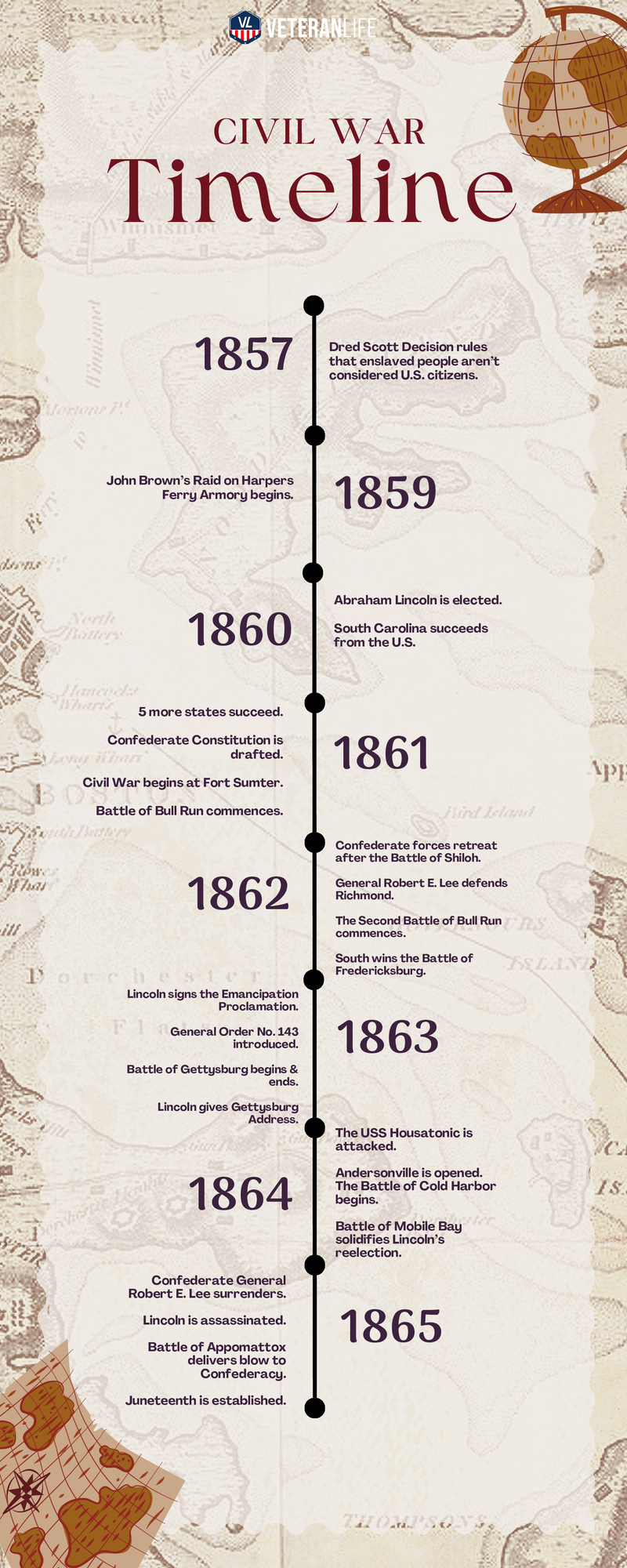KEY CIVIL WAR EVENTS: SHAPING AMERICA'S HISTORY

Depending on who you ask, you’ll find that the Civil War timeline has as many as 100 to more than 200 battles total. At least 50 of them are major events. From 1860 until 1865, the United States found itself incomplete once the Confederacy began, split due to a number of factors primarily centered around slavery.
American Civil War: Key Events by Year
Understanding the Civil War timeline remains an important part of our nation’s history, as it’s one of the most notable events to occur so far.
The timeline of the Civil War is quite detailed considering the amount of events that took place within such a relatively small period of time.
Furthermore, things are a bit more complicated than you might think. For example, while the North opposed slavery, many abolitionists opposed equal rights for Blacks.
The Confederacy may have been its own government but there were many living in the South who wanted a reunification to occur.
At the end of the day, the Union won and our nation was restored, but that doesn’t mean a lot didn’t happen to get us back to this reality.
While it won’t cover every major event in the Civil War, here’s a timeline of notable events, year-by-year, that tore families, states, and our nation apart unlike anything else:
1860
If you edit the Civil War timeline from 1861 to 1865, you end up missing out on several notable events that sparked the conflict in the first place.
The events in 1860 that took place serve as a sort of prequel to the conflict, which started the war for a few reasons:
- States felt powerless in the South.
- Abraham Lincoln solidified this notion by winning the role of President, on November 6, 1860.
- On December 20, 1860, South Carolina succeeded from the U.S.
It’s no surprise that the state responsible for the first shots fired of the Civil War would exit first. These events set the stage, and destruction followed soon after.
1861
In the early months of 1861, several states would secede from the United States, including Mississippi, Florida, Alabama, Georgia, and Louisiana, all before February.
On February 1, Texas also followed suit to join the Confederacy, with Virginia, Arkansas, North Carolina, and Tennessee also leaving the U.S. the same year.
The Confederate Constitution and the first President of the Confederate States of America was chosen in February 1861 as well.
However, the first officially recognized event would take place on April 12, 1861, when the Confederates started firing on Fort Sumter in South Carolina to which the Union forces eventually surrendered.
Three days later, President Lincoln began asking for volunteers to stop Confederate forces, as more states left the Union.
On July 21, 1861, the Battle of Bull Run, or the Battle of Manassas, was the first official battle to take place. The Confederacy would win.
Less than a month later, on August 10, 1861, another Confederate victory would come during the Battle of Wilson's Creek, Missouri, showcasing a notable influence with rebel forces.
This is yet another notable portion of the Civil War timeline where the Union saw success in closing ports; however, the Battle of Ball's Bluff would create another Confederacy victory near the Potomac in October.
1862
The timeline of the Civil War doesn’t start off great for the Union. Many important events early on went the way of the Confederacy, complicating matters.
However, 1862, was kinder to Federalists who were able to secure major victories at the Battle of Mill Springs, Kentucky, during the Surrender of Fort Henry, Tennessee, the Battle of Roanoke Island, the Surrender of Fort Donelson, Tennessee, the Battle of Pea Ridge, Arkansas, the Battle of Shiloh, Tennessee, and the reclaiming of the mouth of the Mississippi River and New Orleans, all occurring within the first four months.
Still, the tides would not completely turn on the Confederacy who would still find victories, thanks to the likes of Confederate Generals "Stonewall" Jackson and Robert E. Lee.
Some notable Civil War battles won in 1862 by the Confederacy include:
- The Second Battle of Bull Run on August 30 and 31, 1862.
- Gen. Lee’s first invasion of the North at the Battle of Antietam, the bloodiest day of the conflict, on September 17, 1862.
- The Battle of Fredericksburg in December was an important win for the South, who was looking to make a mark before the inevitable release of the Emancipation Proclamation.
1863
President Lincoln released the Emancipation Proclamation on January 1 to free slaves in states still controlled by rebels; however, the Civil War timeline was still unfolding.
If anything, this strengthened Southern resolve and showed the seriousness of Lincoln to get the job done despite harsh obstacles.
This was the year in which conscription began for the Union as several battles would take place influencing the Civil War, including:
- Overtaking the Confederate forces with influence over the Mississippi River in April 1863.
- The Battle of Chancellorsville, Virginia, where Stonewall Jackson would die late April to early May.
- General Order No. 143 was introduced on May 22, 1863, a major military policy change, allowing for the United States Colored Troops.
- The Battle of Gettysburg, from July 1 to July 3, put an end to Gen. Lee’s attempt to invade the North. A day later, during the Battle of Vicksburg, the Union won again, furthering its control of the Mississippi River.
- General Order 252 was issued as Black troops were not treated as whites by Confederate forces, hindering prison exchanges. Sadly, this only made things worse.
- President Lincoln’s infamous Gettysburg Address speech takes place on November 19.
- The Siege of Knoxville, Tennessee in late November through early December would cap off a year where the Union took heavy losses but emerged victorious through key battles.
1864
There are plenty of interesting parts of the Civil War timeline that occurred in 1864. Overall, the end was near, and though the South put up a fight, there was an undeniable shift for the Union, who would take several key Southern strongholds:
- The first successful submarine attack of the war took place on February 17, courtesy of the CSS H.L. Hunley’s attack on the USS Housatonic.
- Only ten days later, the deplorable Andersonville Prison Camp opened.
- On March 10, 1864, the Union launched its Red River Campaign. Although involving multiple locations, it was a notable event for overtaking the state of Louisiana.
- Virginia found itself opening up the Overland Campaign on May 5, 1864, with the Battle of the Wilderness. Two days later, the Atlanta Campaign would also begin.
- To begin June, for over two days, the Battle of Cold Harbor, Virginia, raged on as Lee would retain control in the aftermath.
- Although Atlanta would fall in the Battle of Peachtree Creek less than a month later, the Battle of Kennesaw Mountain, Georgia, on June 27, 1864, was bloody and temporarily boosted morale for the Confederacy.
- August was not kind to the Confederate supply chain. During this part of the American Civil War timeline, multiple battles over vital railroads would go the way of the Union. However, at the beginning of the month, it was the Battle of Mobile Bay that helped solidify President Lincoln’s next term and took away a scarce port for the Confederates.
- September and October were more of the same, as the tides had turned. The rebels lost control of Atlanta as well as multiple strongholds in Virginia through various battles.
- From November 16, 1864, until December 10, 1864, Sherman's March to the Sea devastated both Confederate and civilians in Georgia.
- On December 16, 1864, John Bell Hood and the Confederates suffered a defeat ending Tennessee’s stronghold during the Battle of Nashville.
1865
The final year of the American Civil War timeline would ultimately bring about a Union victory and reunify our nation.
Several notable events took place to make this happen; however, including the capture of Fort Fisher in North Carolina, a major win effectively ending port access on the east coast in January.
A similar defeat in Wilmington, North Carolina, further hindered port access for the rebels a little over a month later.
On March 4, 1865, President Lincoln officially began his second term, which would come to an abrupt end on April 15, 1865, when he was assassinated at Ford’s Theatre. Vice President Andrew Johnson was sworn in as POTUS the following day.
Beginning in March, the writing began to be seen on the wall, as several Confederate strongholds were occupied by Union forces, including Fayetteville, North Carolina, the Battle of Five Forks, Virginia, and the captures of Richmond and Petersburg, Virginia.
On April 9, the Battle of Appomattox Court House delivered a major blow to the Confederacy and ultimately would create the surrender of Virginia’s army.
April and May continued to provide surrenders from the Confederacy, before ultimately, the conflict reached its final battle at Palmito Ranch, Texas.
Despite the Civil War timeline ending with a final battle ending in favor of the Confederacy, it was too little, too late.
On May 26, 1865, the Army of the Trans-Mississippi’s terms of surrender were agreed to by Gen. Simon Bolivar Buckner, and on June 2, 1865, the terms were agreed to, effectively ending the Civil War.
With that being said, there were still some holdouts who either were not notified or simply continued to rebel against the United States.
The most notable example of the holdouts would be Juneteenth, which was an event without conflict, yet took place on June 19, 1865, when Union Maj. Gen. Gordon Granger went to Galveston, Texas, to ensure the Emancipation Proclamation was followed and Confederate laws were abolished.
Civil War Key Milestones Overview

Suggested reads:
BY BUDDY BLOUIN
Buddy Blouin is a Contributing Writer at VeteranLife.com
Buddy Blouin is a Contributing Writer at VeteranLife.com



